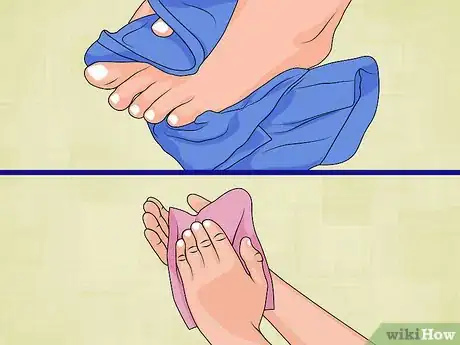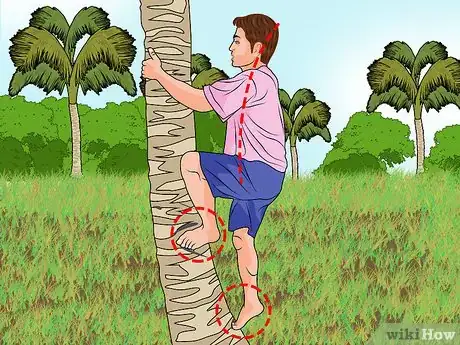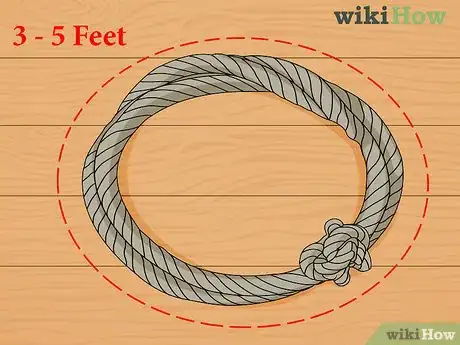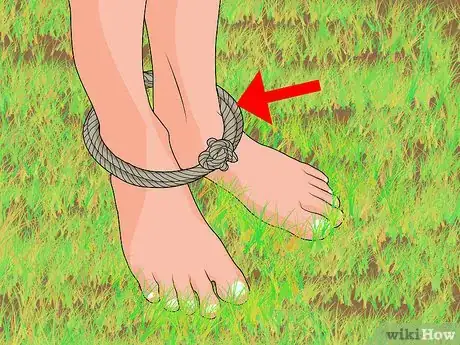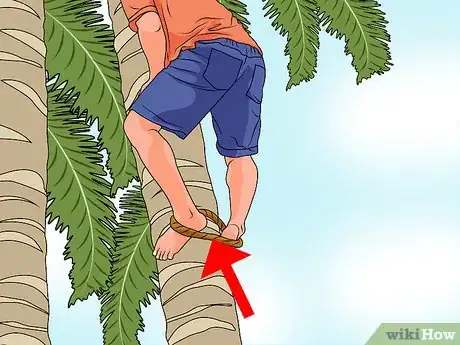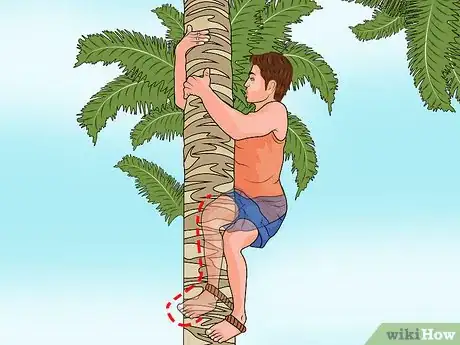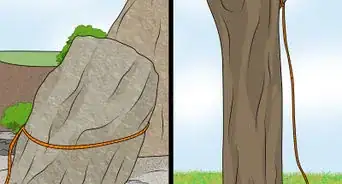This article was co-authored by wikiHow Staff. Our trained team of editors and researchers validate articles for accuracy and comprehensiveness. wikiHow's Content Management Team carefully monitors the work from our editorial staff to ensure that each article is backed by trusted research and meets our high quality standards.
There are 9 references cited in this article, which can be found at the bottom of the page.
This article has been viewed 74,550 times.
Learn more...
Whether it’s to retrieve a lost kite or forage for fresh coconuts, learning how to climb a palm tree is a useful skill to have in the wild. Unlike other types of trees with sturdy branches that can help support your weight, the trunks of palm trees are tall, branchless shafts, which means you’ll have to make the climb unassisted. Fortunately, there are a couple different techniques that, along with a single basic tool, will allow you to easily scale a towering palm and return to the safety of the ground below.
Steps
Walking Up the Tree
-
1Make sure your hands and feet are clean. Before you get started, wipe off any dirt or sand residue that might be on the palms of your hands or the soles of your feet. Make sure your hands and feet are completely dry if you’ve recently been in the water. Moisture and grit can cause you to slip on the way up, making your climb more difficult.[1]
- Climbing smooth, branchless trees like palms is all about getting sufficient traction against the trunk.
-
2Plot your path. Look straight up at the tree trunk and examine its features from all angles. Observing how the trunk curves, where it narrows or gets thicker, and whether or not there are leaves or other protrusions sticking out can help you decide on the best route and technique. Try to find a path that is straight, free of obstacles and doesn’t require you to overcome an inclined curve.
- Most palms and similar trees won’t have any sizable obstructions in the way, but you may encounter knotholes, loose bark and other potential dangers. Always scout the tree out before climbing. It will give you a better sense of where exactly you’ll need to place your hands and feet, as well as any unusual angles you might have to negotiate.[2]
Advertisement -
3Check to see if there are grooves on the tree. There are many different varieties of palms and similar trees. On some palms, the fibrous bark grows in scale-like circular ridges around the length of the trunk. These types of palms will be much easier to climb, as the grooves will act as small hand and footholds. If the tree you’re climbing does not have grooves, you’ll need to be much more confident in your grip and technique.[3]
- Grooved palm trees provide just enough of a ledge to hook your fingertips and toes on.
- Smooth trees can still be climbed with ease; you’ll just have slightly less margin of error.
-
4Wrap your hands around the base of the tree. Stand at arm’s length from the tree. Reach both hands around the base, one higher and one lower, and cup them around the trunk’s backside. Press your fingers firmly into the tree’s surface to get a solid grip. Lean your upper body back so that both arms are straight and pulling against the tree.[4]
- In order to effectively walk up the trunk, you need to create and maintain a counterbalance each time you move a hand or foot.
- You can bend your arms a little once you get moving, as long as they don’t lose tension.
-
5Walk up the tree trunk. With your arms outstretched and your body leaning away, you should have enough space between yourself and the tree to get your first foot up on it. Place the foot around hip height. Then, push with your leg as you pull toward the tree with your arms. Lift your opposite foot and position it on the trunk above your first foot. At the same time, move your lower hand up and grip the tree above your other hand. Repeat this action, using the balance created by pushing and pulling simultaneously to stabilize yourself, until you reach the top of the tree.[5]
- Take small steps. Don’t try to overreach. Placing your foot too high or pushing too forcefully against the trunk can make it hard to hold on with your hands.
- To maximize your grip and agility, only the ball of the foot and toes should be in contact with the tree.
-
6Climb down carefully. When you’re ready to come down, reverse the walking motion and work your way down the tree slowly. Be careful—you’ll be in a less stable position while you’re descending. Alternate the placement of your hands and feet as you lower yourself, keep your arms taut and pushing against the trunk with your legs the whole time.[6]
- Go slowly. Getting down is usually trickier than going up.
- There may be times when you’re forced to slide your feet rather than taking individual steps. If this happens, keep your muscles tight and your hands moving so you don’t lose control.
Shimmying With a Rope
-
1Make a small circle with a rope. A more expedient method of climbing involves using a rope, sarong (a length of fabric typically worn as a sash) or strand of natural plant fiber. The rope or other material should be between 3-5 feet long, depending on the girth of the tree. Fashion a circle out of the rope and tie it securely. You will be using the rope as a brace for your legs, which will enable you to scale the tree quickly and easily.[7]
- Using a rope or another similar device increases surface area contact with the tree, which means you can use the strength of the tree to support much more weight with minimal effort.[8]
- Test the knot you tied in the rope and confirm that it will hold before using it to climb.
-
2Loop the rope over your feet. Twist the rope over in a Figure 8 configuration. This will ensure that the two sides of the rope stay together, and that it is strong enough in the center to hold your full body weight. Drape each looped end of the rope over the outer edge of your foot, near the ankle. Try not to let the rope drift out of place as you climb.[9]
- Doubling the rope over in a Figure 8 shape also neatly creates two little stirrups, one for each foot.[10]
- Once you’ve begun climbing, the rope loops should rest directly under the midpoints of your feet.
-
3Get into position on the tree. Move in close to the tree and grip the back of the trunk with both hands. Hop up quickly and place both feet on either side of the trunk so that the rope is stretched tight across the front. With the high amount of tension on rope, you can now “stand” on the trunk as you climb. This will be even easier if the tree you’re climbing has grooves.[11]
- Practice jumping onto the trunk and “standing” on the rope a few times near the bottom of the tree before going any higher.
- The further your upper body is from the tree trunk, the more weight you’ll be able to rest on the rope. If you were to stand completely vertical, you would simply slide down the tree.
-
4Pull with the arms while pushing against the tree. Gain elevation by using little hops to bring your legs higher up on the trunk, then extend your body and reach to take a new grip. It’s important that you hold on tight and push into the tree with the rope in order to steady yourself. Time your movements so that your feet are in a stable position when you reach, and you’ve got a decent handhold before you bring your legs up.[12]
- Your feet should be pointed at a downward angle so that you can grip and press into the trunk with your toes.
- Just like the walking method, the key is finding the right balance in tension. The legs push away from the trunk and give you room to move, while the arms pull you towards it and upwards, keeping you on the right track.
-
5Shimmy your way up the tree slowly. Continue hopping and pulling to climb to the top of the tree. Take your time and be certain that the rope is anchored before reaching for your next handhold—rushing might cause you to slip. If at any point you start to get tired, you can rest by crouching with your weight over the rope and hugging the tree tight with one or both arms.
- Make each hop controlled and concise. Only try to move 1-2 feet each time.
- Think of the climbing motion as two repeated steps: hop, reach, hop, reach.
-
6Return to the ground safely. Getting down from the top of the tree is as easy as sliding down. Let your hands grip the sides of the trunk loosely to help you control your weight on the weight down. Don’t let your knees or forearms rub up against the trunk as you slide, or you might scrape them. You may have to use a combination of sliding and scooting motions to descend quickly if the tree is grooved.[13]
- It’s a little easier to slide down if you’re climbing with the aid of a rope or sarong, as there is less risk of scraping up your feet.
- Never drop from so high that you can’t make a safe landing.[14]
Warnings
- Chances are, you're going to get a few scrapes and splinters the first few times you climb a palm tree. This just goes with the territory. The more you climb, the tougher the skin on your palms and soles will get.⧼thumbs_response⧽
- Beware of old or dead fronds that cling to the trunk beneath the greener fronds. These may look like convenient handholds, but they are usually brittle and easily broken. Grabbing the wrong frond could send you back to the ground the hard way.⧼thumbs_response⧽
- There may be laws in some areas prohibiting you from damaging palm trees. Stay away from places where you're not supposed to be climbing.⧼thumbs_response⧽
Things You'll Need
- Rope, sarong or flexible plant fiber tied into a circle
References
- ↑ https://www.youtube.com/watch?v=QSi_Aei1cAs
- ↑ http://www.palmtreepassion.com/palm-tree-trunks.html#.V-2r7fArLIU
- ↑ http://www.palmtreepassion.com/palm-tree-trunks.html#.V-2r7fArLIU
- ↑ http://ambergriscaye.com/cocopalms/climbing.html
- ↑ https://www.youtube.com/watch?v=qbpg2kLwd4Q
- ↑ http://ambergriscaye.com/cocopalms/climbing.html
- ↑ https://www.youtube.com/watch?v=QSi_Aei1cAs
- ↑ https://www.polynesia.com/Tree_Climbing_Release.html#.V-2oufArLIU
- ↑ https://www.youtube.com/watch?v=5dNiLa0IMKg
